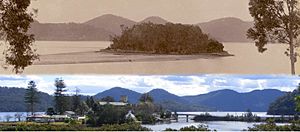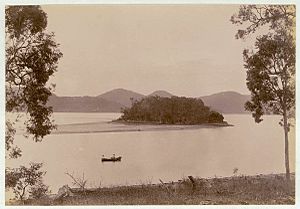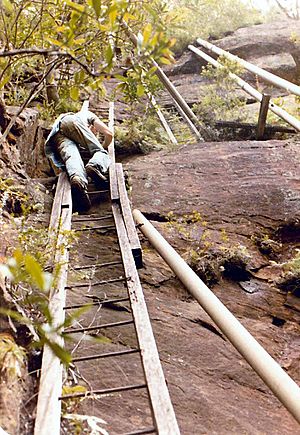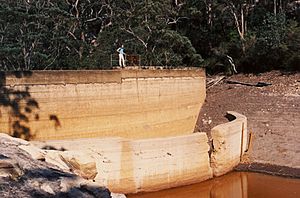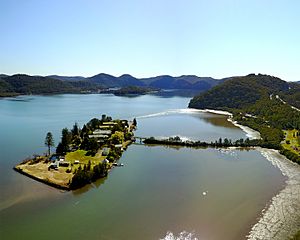Peat Island facts for kids
Peat Island is a small island, about the size of eight football fields, located in the Hawkesbury River. It's just north of Sydney, New South Wales, Australia. The island is part of the area called Mooney Mooney. You can find it a little way upstream from the big bridge that carries the Sydney – Newcastle Freeway. Other islands in the Hawkesbury River include Dangar Island, Spectacle Island, Milson Island, Long Island and Lion Island.
Peat Island's Past
Peat Island was first known as Rabbit Island. This was probably because people kept rabbits there, as far back as 1841! Back then, a report mentioned it was "numerously stocked as a Rabbit Warren." The island only got its current name, Peat Island, in 1936. It was named after Peat's Ferry, which used to cross the Hawkesbury River nearby. George Peat was an early settler and boat builder who started this ferry service in 1844.
Building on the Island
In the 1890s, the government in New South Wales decided to build a special place for people who needed help with certain health issues. They wanted a quiet, isolated spot. Laws were passed in 1900, and a doctor named J. M. Creed chose Peat Island and nearby Milson Island for these new facilities. Peat Island was chosen for women, and Milson Island for men.
Construction started in 1902. Workers cleared and leveled Peat Island. They built several buildings, including the large brick ones you can still see today. To get fresh water for both Peat and Milson Islands, a big concrete dam was built. It was 24 feet high and could hold 7 million gallons of water! This dam was located in a gully on the northern bank of the Hawkesbury River, a few kilometers upstream.
Workers used rock and sand from the area for the dam. But cement and other materials had to be pulled 275 feet up the cliff from the river using old Sydney tram cables. The only way to reach the dam was by climbing five almost vertical timber and iron ladders fixed into the cliff face. A pipeline then carried water from the dam to both islands through underwater pipes.
Later, a taller dam was built a few meters downstream to hold even more water. The original dam wall is still there, hidden underwater, but you can sometimes see it during very dry times. The old ladders on the cliff were damaged in the 1994 bushfires. Eventually, both islands were connected to Sydney's main water supply, so the dam was no longer needed.
Building this facility in such a remote spot was very expensive, and some people criticized the cost. After it was finished in 1905, the new buildings sat empty for a few years, looked after by a caretaker. Government officials sometimes used it for picnics.
By 1907, the government decided to use the facility as a hospital for people with mental health challenges. It was handed over to the Lunacy Department in 1908.
Life at Peat Island Hospital
The first twenty patients arrived in March 1911. The hospital began to grow, starting as a place only for men. Patients and staff worked hard to build paths and gardens. They also spent ten years building a stone causeway and bridge to the mainland, which was finally finished in 1957. Over many years, the hospital grew beyond the small island. New buildings, like a chapel, were added on the nearby mainland, mostly in the 1950s and 1960s.
Even though the location was beautiful, life at the hospital could be tough, especially in the early years. Many patients who passed away were buried in a nearby cemetery in Brooklyn.
As people's understanding of mental health and developmental disabilities changed, the hospital facilities improved. A school was opened in 1951 when it was realized that the boys would benefit from learning. Many patients were boys (girls were admitted starting in the 1970s). Some of these children had no family visits, and the dedicated staff often provided a stable and caring home for them. Many patients lived their entire lives on the island, having been admitted as children.
The hospital also ran a small shop called a "canteen" on the Pacific Highway at Mooney Mooney. It sold fuel and takeaway food until 2010. Some patients were allowed to move freely in the nearby area, and local people often looked out for them to make sure they were safe.
The Hospital Closes
In 1983, a report on mental health services in New South Wales suggested that places like Peat Island should close. The idea was to help patients live in the wider community if possible. Over the next 27 years, different plans were made for the facility. Finally, it officially closed in October 2010. The last residents moved to new facilities on the Central Coast, in places like Hamlyn Terrace and Wadalba.
After the closure, there were rumors that the island might become a place for asylum seekers, but both the state and federal governments said this was not true. Today, the facility is empty and boarded up, waiting for a decision about its future from the New South Wales State Property Authority.


